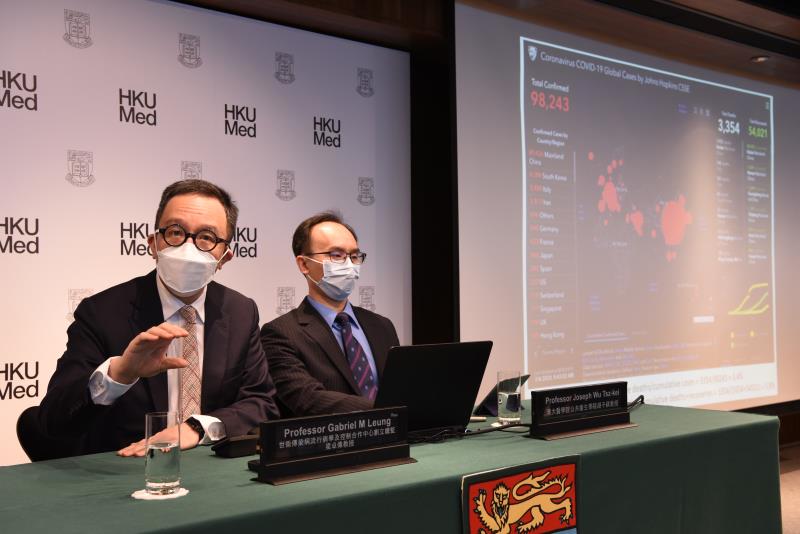 Prof Gabriel Leung (left), Prof Joseph Wu (right)
Prof Gabriel Leung (left), Prof Joseph Wu (right)The symptomatic case fatality risk (sCFR) of coronavirus disease 2019 (COVID-19) is estimated to be 1.4 percent – much higher than the mortality risk of the 2009 swine flu pandemic – according to researchers from the University of Hong Kong (HKU).
“In this study conducted in collaboration with the Harvard University’s School of Public Health, we estimated the sCFR of COVID-19 in Wuhan, China, based on cases exported internationally from Wuhan through commercial flights prior to 19 January and chartered flights for expatriates between 29 January and 4 February, as well as data from Chinese health authorities,” said investigator Professor Joseph Wu of the School of Public Health, HKU. [Nat Med 2020, doi: 10.1038/s41591-020-0822-7]
The overall sCFR was 1.4 percent, based on a 0.5 probability of developing symptoms after infection.
In comparison, the overall sCFR of the 2009 swine flu pandemic was 0.026 percent in the UK, with an infection fatality risk (IFR; risk of death among all infections) of <0.1 percent for individuals aged <60 years and 1.1 percent for those aged ≥60 years in Hong Kong. The IFR of the 1918 influenza pandemic was 2.5 percent worldwide.
“Based on our estimates, COVID-19 is much deadlier than the 2009 swine flu, but not as deadly as the 1918 influenza,” said Professor Gabriel Leung, Founding Director of WHO Collaborating Centre for Infectious Disease Epidemiology and Control, HKU.
“Importantly, we found an age-dependent exponential rise in sCFR and susceptibility to symptomatic infection among older individuals. Those above 70 years of age had three times the sCFR compared with the overall population, and three times the susceptibility to symptomatic infection compared with the younger population,” pointed out Leung.
The estimated sCFR was 2.6 percent for individuals aged >59 years, compared with 0.3 percent and 0.5 percent for those aged <30 years and 30–59 years, respectively. Compared with those aged 30–59 years, those aged >59 years were 2 times more susceptible to symptomatic infection. "Special attention should be paid to older individuals, especially those with pre-existing chronic conditions and those residing in nursing homes,” said Leung.
In a recent retrospective, multicentre cohort study of 191 adult patients hospitalized for COVID-19 in Wuhan, older age was identified as a risk factor of increased in-hospital mortality (odds ratio [OR], 1.10 per year increase; 95 percent confidence interval [CI], 1.03 to 1.17; p=0.0043). Other risk factors were higher Sequential Organ Failure Assessment (SOFA) score (OR, 5.65; 95 percent CI, 2.61 to 12.23; p<0.0001), and d-dimer >1 µg/mL (OR, 18.42; 95 percent CI, 2.64 to 128.55; p=0.0033) on admission. The median duration of viral shedding was 20 days in survivors, with the longest observed duration being 37 days. [Lancet 2020, doi: 10.1016/S0140-6736(20)30566-3]
An analysis of public surveillance data in Hong Kong and Shenzhen revealed a 49.7 percent shorter time interval from symptom onset of a primary COVID-19 case to that of a secondary case (ie, serial interval [SI]) among male vs female primary cases. [Infect Control Hosp Epidemiol 2020, doi: 10.1017/ice.2020.64]
On 11 March 2020, the WHO declared COVID-19 a pandemic. As testing capacity is crucial for COVID-19 detection, researchers at HKU’s School of Public Health developed primer/probe sets for rapid testing of severe acute respiratory syndrome coronavirus 2 (SARS-CoV-2) within 6 days after China released the genomic sequence of the virus in January 2020. The reagents have been provided free of charge to public health laboratories in more than 40 countries, and enabled Egypt, Cambodia and Nepal to confirm COVID-19 cases.
Clinical trials of the investigational antiviral agent, remdesivir, have also begun globally. In Hong Kong, randomized phase III trials of remdesivir vs standard of care will be conducted at the Queen Mary Hospital, Princess Margaret Hospital, and Prince of Wales Hospital in patients with moderate or severe COVID-19. [NCT04292730; NCT04292899]